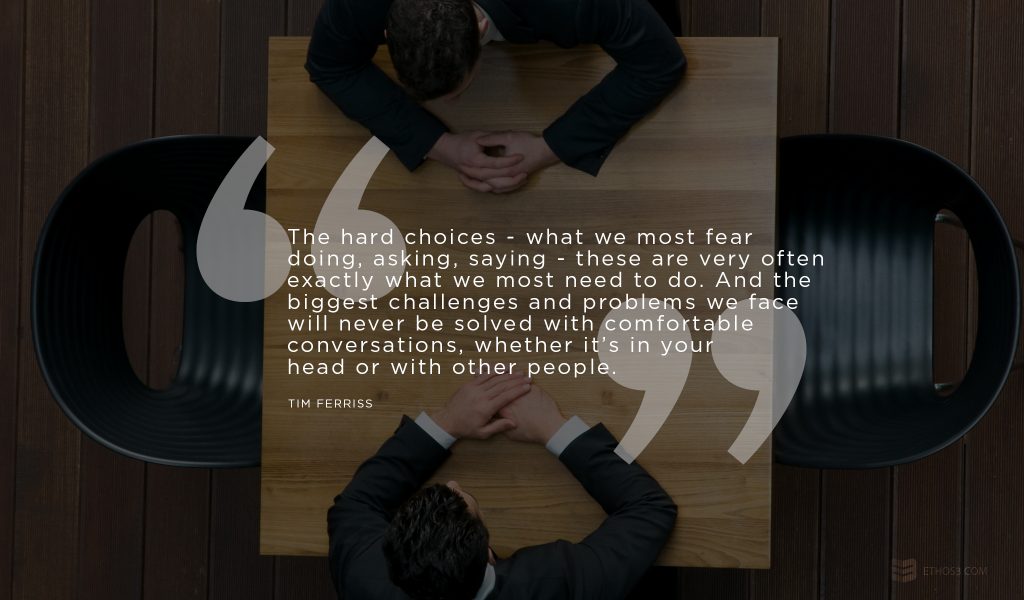Do you ever consider laying out your fears on a piece of paper like you would lay out your goals? That’s what tech investor, author and podcaster Tim Ferriss proposes in his newest TED Talk called, “Why You Should Define Your Fears Instead of Your Goals.” Ferriss explains a three page plan called fear setting to help better your life by taking the chances you might be too afraid to take right now. To apply this task to your everyday life, watch the video below.
What makes Ferriss’ speech so effective? He uses 4 presentation techniques that leave a lasting impact.
Shock Factor
At the very beginning of this TED Talk, Ferriss tells the story about the time he almost committed suicide. Standing in front of an image of his younger self smiling, Ferriss calls out the juxtaposition. He says that despite feeling happy in that moment, he had been suffering a depressive episode and made the decision to end his life. But he decided to go against his plan and instead invested all his headspace to balancing out his emotional ups and downs. This story immediately draws in the audience’s attention and gets them invested in the rest of the presentation. Having a shock factor in your presentation is a compelling way to keep your audience on the edge of their seats for the duration of your speech.
“I went from deciding to full-blown planning very quickly. And I came this close to the edge of the precipice. It’s the closest I’ve ever come. And the only reason I took my finger off the trigger was thanks to a few lucky coincidences. And after the fact, that’s what scared me the most: the element of chance.”
Using Quotes
Using quotes in a presentation is like mastering a cooking recipe. Too much seasoning and your food will be overbearing, but too little seasoning and your food will be bland. You should aim for the middle ground in order to get the perfect taste. In this TED Talk, Ferriss uses quotes thoughtfully and intentionally. He even repeats a quote to make a point and tie his presentation together. This is another presentation technique that can help your content become memorable and impactful. Begin or end your presentation with an inspiring quote that has a personal connection to your life. And re-emphasize the meaning of this quote by circling back to it at some point in your presentation.
“I bought a book on simplicity to try to find answers. And I did find a quote that made a big difference in my life, which was, ‘We suffer more often in imagination than in reality,’ by Seneca the Younger, who was a famous Stoic writer.”

Explain the benefits
It’s one thing to present a new idea or product that can help you solve a problem. It’s another to point out clearly to your audience what they can benefit from using your idea or product. To make a presentation that is persuasive, it’s a good idea to name out the benefits that you have experienced and that your audience can expect. As Ferriss is explaining how his fear setting process works, he also mentions the benefits of each exercise. This gives the audience more incentive to try evaluating their own fears.
“I can trace all of my biggest wins and all of my biggest disasters averted back to doing fear-setting at least once a quarter. It’s not a panacea. You’ll find that some of your fears are very well-founded. But you shouldn’t conclude that without first putting them under a microscope. And it doesn’t make all the hard times, the hard choices, easy, but it can make a lot of them easier.”
End with a Call to Action
For every presentation, there is an end goal to get the audience to do something. Whether it’s buy something, try something, learn something, or ask a question, each presentation should have a call to action. The more compelling, the better. In this TED Talk, Ferriss calls on his audience to reconsider their fears and ask if they are worth the risk. This is a more introspective call to action, but a useful one nonetheless.
“So I encourage you to ask yourselves: Where in your lives right now might defining your fears be more important than defining your goals? Keeping in mind all the while, the words of Seneca: ‘We suffer more often in imagination than in reality.’”
For more TED Talk reviews, check out these related posts:
The Productivity Decline: A TED Talk Review with Yves Morieux
A Passionate Point of View: A TED Talk Presentation Analysis
The Progression of Points in a Recent TED Talk by Pope Francis